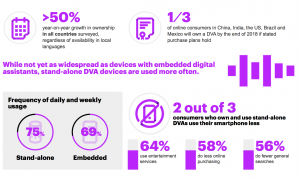May I have your attention, please?!
… Gosh, if only it were that easy! I’m sorry to say that virtual interaction rarely happens on its own. Meaning that, as the salesperson, it is your responsibility to create both the desire and the opportunity for your customer to easily interact with you when on a virtual sales call.
Too many salespeople think of video engagement as lobbing a few questions at their audience or inviting them to type something into the chat. Unfortunately, this simply will not do! With audience attention spans spinning ever downward and distractions on the rise, random acts of forced engagement are not going to produce the consistent level of involvement necessary for your message to be heard and (ideally) acted upon by buyers. To promote attention and interaction successfully, you need to have a plan. This plan should consider the limits on virtual attention, typical social behaviors online, strategies for maintaining attention, and the other interaction tools available to you.
Consider the Limits on Virtual Attention
Unlike when in an in-person meeting, most virtual participants feel little to no obligation to give you their attention! (Nope, not even if you say please). In a virtual sales world, viewers will feel entitled to browse their phones, check an email or two, even enjoy a three-course meal while you are on the call! When not in the same room, expectations fly right out the door.
Typical Social Behaviors When Online
Although it is easy to blame poor interaction on your customer, remember that they are simply doing what they have been trained to do when sitting in front of a screen: passively observe. Whether the newest Netflix original series or your virtual sales call, unless held accountable, audiences are merely consumers of information – passive observers, not active participants. This fact is especially true when your prospect is expecting a presentation or a demonstration where even less engagement is typically expected.
3 Factors for Improving Attention and Interaction
In order to eliminate passive behavior and maintain audience attention, consider movement, relevancy, and variety.
Movement: Movement is one of the quickest ways to gain another person’s attention. For example, have you ever noticed how every head in a room turns when someone walks in the room? Humans respond to movement on a subconscious level, and this also rings true of video calls. Try using purposeful gestures or facial expressions, switch up your content or speakers, use on-screen annotations, polls, or other on-screen activity to gain (and re-gain) your prospect’s attention virtually.
Relevancy: Any type of engagement or interaction should always be relevant and purposeful. Blatant and irrelevant attention-grabbers that lead nowhere waste time and try the patience of busy prospects. While this dog and pony show strategy may be effective in meetings with your team or friends and family, a sales call requires deliberate, heightened communication, and every element, including audience engagement, should be tied to the reason that you are there. No dogs or ponies allowed!
Variety: Humans adapt to patterns. If your presentation is one slide after the other (after the other) or you rely too heavily on a single form of engagement, such as asking one-dimensional questions like, “Does that make sense?”, you run the risk of your customer adapting … and ultimately checking out. You have lost the power of keeping your customer engaged by providing no variety.
Virtual Tools in Your Toolkit
It is critical to have a variety of ways to keep your prospect on their toes when on a virtual sales call. Fortunately, you have a variety of engagement tools in your virtual toolkit to choose from, including:
- Annotating your screen
- Using your mouse or pointer to direct attention
- Switching between full video and slides/content
- Using the whiteboard feature
- Leveraging your voice
- Using gestures and facial expressions
- Asking questions and repeatedly checking in
- Running a poll
Attention and interaction are too important to leave to chance. Take a few minutes to plan out how and when you’re going to get your audience engaged using the three factors of movement, relevancy, and variety and our virtual toolkit as your guide.
Learn the Skills that will take you to the Next Level in Virtual Sales:
In the Selling On Video Master Class you’ll learn the unique skill set how to:
- Make soft, personal eye contact that makes your customer feel heard and seen.
- Understand when and how to look at the camera in a natural way.
- Read customer body language without breaking your connection.
- Understand what that unique video language your customer is using means – and when to react.
- Improve the response rate to your questions and increase interaction.
- Create more actively engaged customers.
- Leverage your body language to reinforce what you’re saying, not distract from it.
- And much more!
Business & Finance Articles on Business 2 Community
(39)





